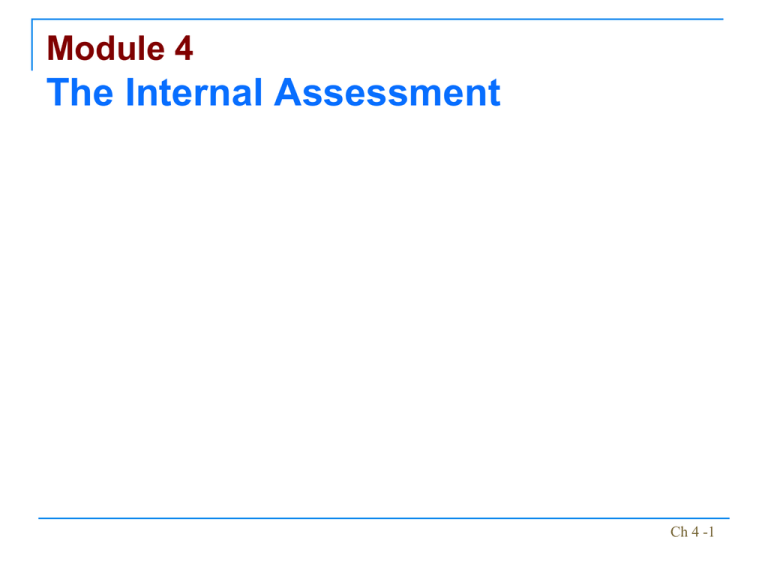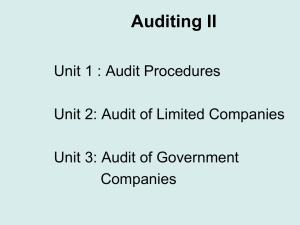Module 4
advertisement

Module 4 The Internal Assessment Ch 4 -1 Ch 4 -2 Internal Assessment “Great spirits have always encountered violent opposition from mediocre minds.” – Albert Einstein “Weak leadership can wreck the soundest strategy.” – Sun Tzu Ch 4 -3 Internal Audit Identify strengths and weaknesses in Management Marketing Finance and accounting Production and operations Research and development Management information systems Ch 4 -4 Nature of an Internal Audit Basis for Objectives & Strategies Internal strengths/weaknesses External opportunities/threats Clear statement of mission Ch 4 -5 Key Internal Forces Distinctive Competencies: Firm’s strengths that cannot be easily matched or imitated by competitors Ch 4 -6 Key Internal Forces Distinctive Competencies: Building competitive advantage involves taking advantage of distinctive competencies Ch 4 -7 Internal Audit Process Parallels process of external audit Information gathered from: Management Marketing Finance/accounting Production/operations Research & development Management information systems Ch 4 -8 Internal Audit Involvement in performing an internal strategic-management audit provides a vehicle for understanding the nature and effect of decisions in other functional business areas of the firm Ch 4 -9 Ch 4 -10 Internal Audit Managers and employees from all areas provide information A team of managers then selects 10 to 15 key organizational strengths and weaknesses to focus on Ch 4 -11 Internal Audit Financial Ratio Analysis Exemplifies complexity of relationships among functional areas of the business Ch 4 -12 Resource Based View (RBV) Approach to Competitive Advantage Internal resources are more important than external factors Ch 4 -13 Resource Based View (RBV) Three All-Encompassing Categories 1. Physical resources 2. Human resources 3. Organizational resources Ch 4 -14 Resource Based View (RBV) Empirical Indicators Rare Hard to imitate Not easily substitutable Ch 4 -15 Integrating Strategy & Culture Organizational Culture Pattern of behavior developed by an organization as it learns to cope with its problem of external adaptation and internal integration . . . is considered valid and taught to new members as the correct way to perceive, think, and feel Ch 4 -16 Integrating Strategy & Culture Organizational Culture Resistant to change May represent: Strength Weakness Ch 4 -17 Integrating Strategy & Culture Values Beliefs Legends Heroes Symbols Cultural Products Myths Rites Rituals Ch 4 -18 Integrating Strategy & Culture Organizational Culture Can Inhibit Strategic Management Miss external changes due to strongly held beliefs Natural tendency to “hold the course” even during times of strategic change Ch 4 -19 Management Functions of Management 1. Planning 2. Organizing 3. Motivating 4. Staffing 5. Controlling Ch 4 -20 Management Function Stage When Most Important Planning Strategy Formulation Organizing Strategy Implementation Motivating Strategy Implementation Staffing Strategy Implementation Controlling Strategy Evaluation Ch 4 -21 Management Planning Beginning of management process Bridge between present & future Improves likelihood of attaining desired results Ch 4 -22 Management Developing a mission Forecasting future events and trends Planning Establishing objectives Choosing strategies to pursue Ch 4 -23 Planning Synergy Can develop through planning Exists when everyone pulls together as a team that knows what it wants to achieve Ch 4 -24 Management Organizing Achieves coordinated effort Defines task & authority relationships Determines who does what Determines who reports to whom Ch 4 -25 Management Organizing Breaking down tasks into jobs Combining jobs to form departments Delegating authority Ch 4 -26 Management Motivating Influencing to accomplish specific objectives Four components include: Leadership Group dynamics Communication Organizational change Ch 4 -27 Management Staffing Personnel management Human resource management Ch 4 -28 Management Staffing Recruiting Interviewing Testing Selecting Orienting Training Developing Caring for Evaluating Rewarding Disciplining Promoting Transferring Demoting Dismissing Ch 4 -29 Management Controlling Establishing performance standards Ensure actual operations conform to planned operations Taking corrective actions Ch 4 -30 Management Controlling 1. Establish performance standards 2. Measure individual and organizational performance 3. Compare actual performance to planned performance standards 4. Take corrective action Ch 4 -31 Management Audit Checklist Does the firm use strategic management concepts? Are objectives/goals measurable? Well communicated? Do managers at all levels plan effectively? Ch 4 -32 Management Audit Checklist Do managers delegate well? Is the organization’s structure appropriate? Are job descriptions clear? Are job specifications clear? Is employee morale high? Ch 4 -33 Management Audit Checklist Is employee absenteeism low? Is employee turnover low? Are the reward mechanisms effective? Are the organization’s control mechanisms effective? Ch 4 -34 Marketing Customer Needs or Wants for Products and Services 1. Defining 2. Anticipating 3. Creating 4. Fulfilling Ch 4 -35 Marketing Marketing Functions 1. Customer analysis 2. Selling products/services 3. Product & service planning 4. Pricing 5. Distribution 6. Marketing research 7. Opportunity analysis Ch 4 -36 Marketing Customer surveys Consumer information Customer Analysis Market positioning strategies Customer profiles Market segmentation strategies Ch 4 -37 Marketing Selling Products/Services Advertising Sales Promotion Publicity Personal Selling Sales force management Customer relations Dealer relations Ch 4 -38 Ch 4 -39 Marketing Product/Service Planning Test marketing Brand positioning Devising warranties Packaging Product features/options Product style Quality Deleting old products Providing for customer service Ch 4 -40 Marketing Pricing Major Stakeholders Consumers Governments Suppliers Distributors Competitors Ch 4 -41 Marketing Distribution Warehousing Distribution channels Retail site locations Sales territories Inventory levels Transportation Wholesaling Retailing Ch 4 -42 Marketing Gather data Marketing Research Record data Analyze data Ch 4 -43 Marketing Assessing costs Cost/Benefit Analysis Assessing benefits Assessing risks Ch 4 -44 Marketing Audit 1. Are markets segmented effectively? 2. Is the organization positioned well among competitors? 3. Has the firm’s market share been increasing? 4. Are the distribution channels reliable & cost effective? 5. Is the sales force effective? Ch 4 -45 Marketing Audit 6. Does the firm conduct market research? 7. Are product quality & customer service good? 8. Are the firm’s products and services priced appropriately? 9. Does the firm have effective promotion, advertising, and publicity strategies? Ch 4 -46 Marketing Audit 10. Are the marketing, planning, and budgeting effective? 11. Do the firm’s marketing managers have adequate experience and training? 12. Is the firm’s Internet presence excellent as compared to rivals? Ch 4 -47 Finance/Accounting 1. Investment decision (Capital budgeting) 2. Financing decision 3. Dividend decision Ch 4 -48 Basic Financial Ratios Firm’s ability to meet its short-term obligations Liquidity Ratios Ratios Current ratio Quick (or acid test) ratio Ch 4 -49 Basic Financial Ratios Extent of debt financing Ratios Leverage Ratios Debt-to-total assets Debt-to-equity Long-term debt-to-equity Times-interest-earned Ch 4 -50 Basic Financial Ratios Effective use of firm’s resources Ratios Activity Ratios Inventory turnover Fixed assets turnover Total assets turnover Accounts receivable turnover Average collection period Ch 4 -51 Basic Financial Ratios Effectiveness shown by returns on sales and investment Profitability Ratios Ratios Gross profit margin Operating profit margin Net profit margin Return on total assets (ROA) Ch 4 -52 Basic Financial Ratios Effectiveness shown by returns on sales & investment Profitability Ratios (cont’d) Ratios Return on stockholders’ equity (ROE) Earnings per share Price-earnings ratio Ch 4 -53 Basic Financial Ratios Firm’s ability to maintain economic position Ratios Growth Ratios Sales Net Income Earnings per share Dividends per share Ch 4 -54 Growth Ratios Ratio Sales Annual percentage growth in Total sales Net Income Profits Earnings per share EPS Dividends per share Dividends per share Ch 4 -55 Ch 4 -56 Ch 4 -57 Ch 4 -58 Ch 4 -59 Finance/Accounting Audit 1. 2. 3. 4. 5. Where is the firm financially strong/weak as indicated by financial ratio analysis? Can the firm raise needed short-term capital? Can the firm raise needed long-term capital through debt and/or equity? Does the firm have sufficient working capital? Are capital budgeting procedures effective? Ch 4 -60 Finance/Accounting Audit 6. 7. 8. 9. Are dividend payout policies reasonable? Does the firm have good relations with its investors and stockholders? Are the firm’s financial managers experienced and well trained? Is the firm’s debt situation excellent? Ch 4 -61 Production/Operations Production/Operations Functions Process Capacity Inventory Workforce Quality Ch 4 -62 Ch 4 -63 Production/Operations Audit •Are suppliers of materials, parts, etc. reliable and reasonable? •Are facilities, equipment, machinery, and offices in good condition? •Are inventory-control policies and procedures effective? Ch 4 -64 Production/Operations Audit •Are quality-control policies & procedures effective? •Are facilities, resources, and markets strategically located? •Does the firm have technological competencies? Ch 4 -65 Research & Development Research & Development Functions Development of new products before competitors Improving product quality Improving manufacturing processes to reduce costs These functions can be done internally or externally Ch 4 -66 Research & Development Financing as many projects as possible Use percent-of-sales method R&D Budgets Budgeting relative to competitors How many successful new products are needed Ch 4 -67 Research & Development Audit •Are the R&D facilities adequate? •If R&D is outsourced, is it cost-effective? •Are the R&D personnel well qualified? •Are R&D resources allocated effectively? Ch 4 -68 Research & Development Audit •Are MIS and computer systems adequate? •Is communication between R&D and other organizational units effective? •Are present products technologically competitive? Ch 4 -69 Management Information Systems Purpose Improve performance of an enterprise by improving the quality of managerial decisions Ch 4 -70 Management Information Systems Audit Do all managers use the information system to make decisions? Is there a CIO or Director of Information Systems position in the firm? Are data updated regularly? Do managers from all functional areas contribute input to the information system? Are there effective passwords for entry into the firm’s information system? Ch 4 -71 Management Information Systems Audit Are strategists of the firm familiar with the information systems of rival firms? Is the information system user-friendly? Do all users understand the competitive advantages that information can provide? Are computer training workshops provided for users? Is the firm’s system being improved? Ch 4 -72 Value Chain Analysis The process whereby a firm determines the costs associated with: Purchasing raw materials Manufacturing products Marketing products And compares them to the value chain of rival firms Ch 4 -73 Value Chain Analysis Core competencies Distinctive competencies Benchmarking Ch 4 -74 Transforming Value Chain Activities into Sustained Competitive Advantage Value Chain Activities Are Identified and Assessed Core Competencies Arise in Some Activities Some Core Competencies Evolve into Distinctive Competencies Some Distinctive Competencie s Yield Sustained Competitive Advantages Ch 4 -75 Internal Factor Evaluation (IFE) Matrix 1. List key internal factors 2. Assign a weight ranging from 0.0 to 1.0 3. Assign a 1 to 4 rating to each factor 4. Multiply the weight times the rating 5. Sum the weighted scores Ch 4 -76








